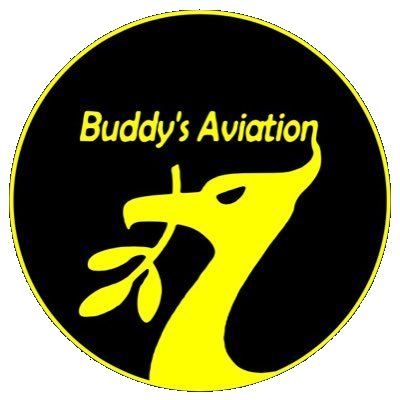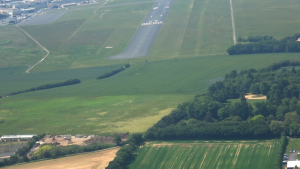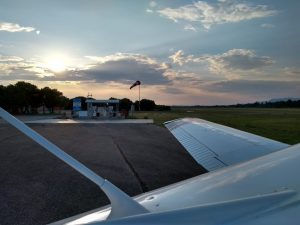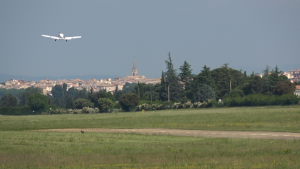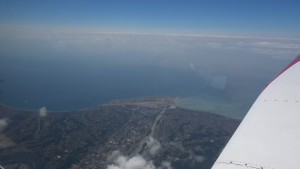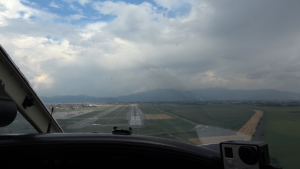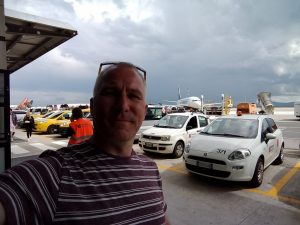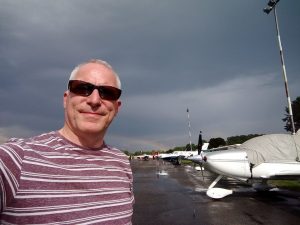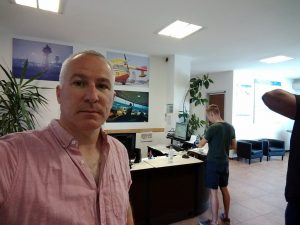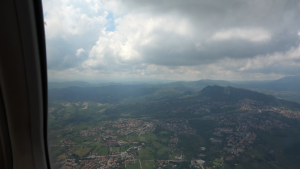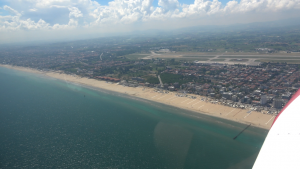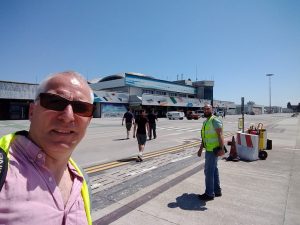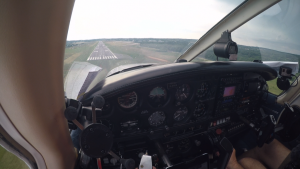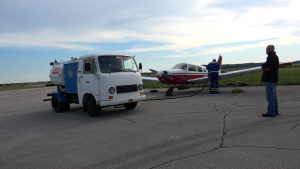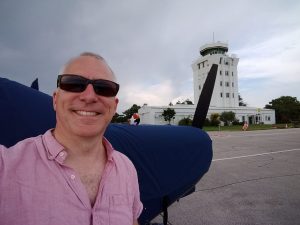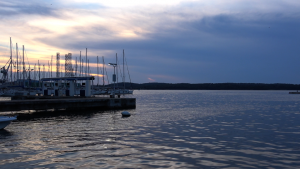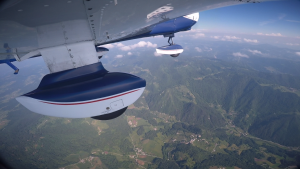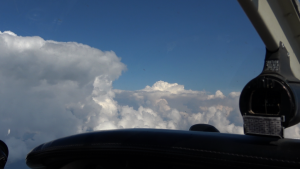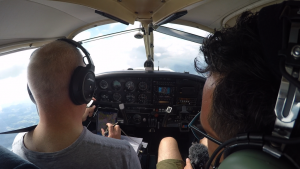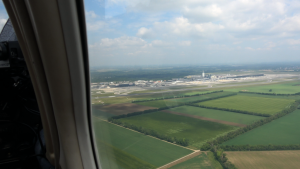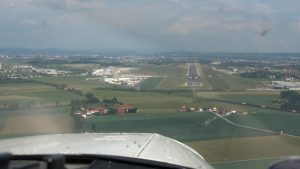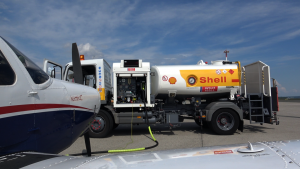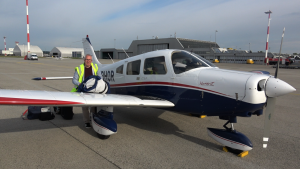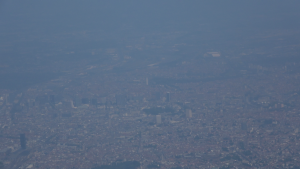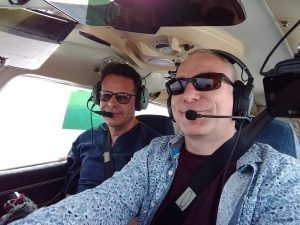
In May 2018 I joined three other aircraft on a five day tour of Europe, flying through France, Italy, Croatia, Slovenia, Austria, Germany and Belgium. If you’d like to do something similar, but lack the confidence, you might want to consider contacting my mentor for this trip, James Lee of Buddy’s aviation. James specialises in hour building trips like this, around the UK and Europe.
16 May 2018
Lydd – Le Touquet – La Rochelle – Carpentras
Leg 1 of 10: Le Touquet to La Rochelle, Flight time: 2 hours 27 minutes, Distance: 295nm
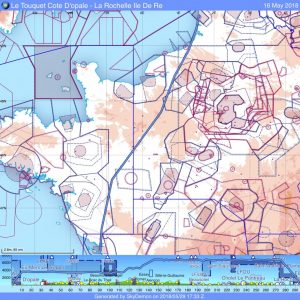
I’m based at Redhill Aerodrome, and partly due to our take off weight with full fuel, and the restrictive SERA rules on Class D airspace, I opted to start the trip from Lydd with full fuel. The three other aircraft I was flying with, departed Stapleford, but refuelled at Le Touquet, so I joined them there. All the flight planning formalities were handled with ease, thanks to Sky Demon.
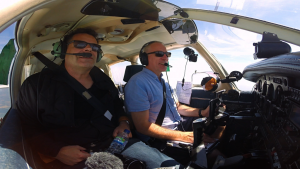
Weather conditions were fine, if a little hazy, and we had the wind behind us. It had been our intention to route over the Alps, but a deeply unstable atmosphere over central Europe meant we had to re-think our plan.

Number 2, to company traffic on final at La Rochelle
To avoid the weather over the higher ground, we routed south west towards La Rochelle. There was very little airspace to concern us, and the first leg was extremely enjoyable. We landed at La Rochelle after 2 hours and 27 minutes, and fuelled the aircraft in turn.
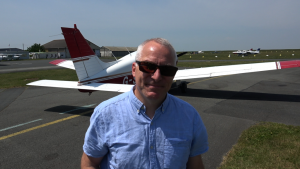
During the course of this trip around Europe, we found that fuelling and paying fees could sometimes be a real drag. This wasn’t the case at at all of our stops, but at La Rochelle the fuelling took a little while longer than one would expect. The fueler’s system was to fill up each aircraft before walking back to the office to process the paperwork. Only then would he take on the next customer. This meant that fuelling the four aircraft probably took somewhere in the region of an hour.
It looked as if La Rochelle had a new terminal, but it was deserted, the cafe was closed, and we were left with a vending machine taking cash only.
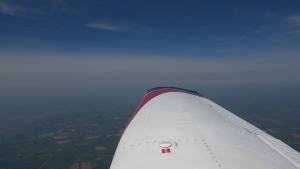
After all the aircraft were fuelled, we departed towards Carpentras, in the south of France.
La Rochelle Landing Fee: €11.02
Fuel Price: €1.243 per litre, plus 45% tax, plus 20% VAT
Leg 2/10: La Rochelle – Carpentras, flight time: 3 hours 35 minutes, distance: 282nm
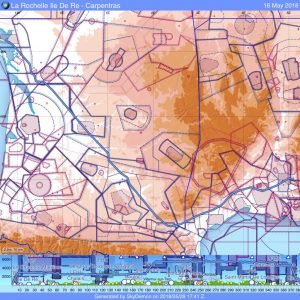
What was evident about all our time flying through France, was the helpful cooperation of French ATC. We were cleared through controlled airspace without quibble or difficulty, and were given our requested climbs, descents and deviations without question. Quite often, what looked like a very difficult stretch of airspace on the map, was transited with minimal RT. We’d often check on restricted airspace to find that it was no longer restricted, or requests to transit it were responded to with a cheery “approved”.
We arrived at Carpentras early evening. It’s an A/A aerodrome, so traffic calls were made on the published frequency. The strip was narrow, but well maintained, and the taxi back was on the grass. There was no one at the aerodrome when we landed, so we fuelled ourselves using the self service pumps. Getting a taxi to our accommodation was more tricky, as there was a big local football match underway, and everyone was busy. We found someone in the end.

Carpentras
After a restful, yet sociable evening, we set course the next day for Pula in Croatia.
Landing fees: TBC
Fuel prices: €1.950 per litre
17 May 2018
Carpentras – Pisa (Diversion) – Lucca
Leg 3/10: Carpentras – Pisa, distance 271nm, flight time 2 hours 42 minutes.
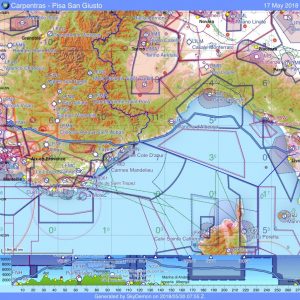
As I had to spend some extra time fiddling with cameras, throughout the trip, I was usually the last of the four aircraft to depart.

The group departs from Carpentras
There was some very high ground to clear on our track out of Carpentras, and while the others seemed to have got away easily, I struggled to gain the height straight away, while avoiding the clouds. I ended up circling and climbing near Carpentras for a while, and then weaved my way through the clouds, before getting on top and past the high ground.

Nice from FL100
Our track routed us near Nice, a very busy international aerodrome, with complicated and restrictive airspace, but we cleared through it without hindrance. At one point I was asked if I could climb to FL100, and was asked to remain over land, but that was it. The controllers were amazing.
As we crossed the Ligurian Sea in Italy, to the south of Genoa, the weather started to throw us some difficulties. There were growing CBs, and embedded CBs out at sea, and the sky looked very menacing. There was low stratus cloud too over the coast near Pisa. My mentor for the trip, James Lee, was in the lead aircraft, and told the group we would divert to Pisa. Our original plan had been to cross over Italy, and land in Croatia.
James said that the controllers initially asked if we would consider a smaller aerodrome, but the weather was closing in, and the runway at the aerodrome they were suggesting was too short, and would have prevented us departing again at our respective weights.
Pisa asked us to set up for vectors for the VOR approach to runway 04R VFR. I checked the charts and tuned the frequencies, but it wasn’t possible to accept the vectors while at the same time remaining in VMC, so we positioned visually. The controller I was talking to was absolutely fantastic, and also comforting. As I landed, a Ryanair jet was made to hold short for my approach.

Landing at Pisa
After landing, I think almost all of us struggled with the taxi instructions. The rich Italian accents weren’t immediately understood, and I thought I was told to exit 1st left, which I read back. After exiting 1st left, they abruptly told me they had wanted me to exit 3rd left. We parked on the General Aviation apron, and waited for a large bus to drive us to the General Aviation arrival point. We had a problem though, Pisa didn’t have any Avgas.

Waiting for the storms to clear at Pisa
Pisa landing & handling fees: In the region of €100
Leg 4/10: Pisa to Lucca, distance 24nm, flight time 16 minutes
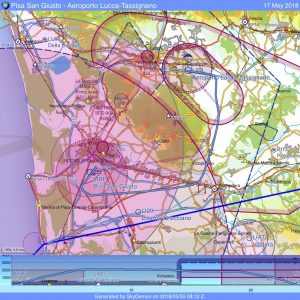
We had lunch, and checked the weather, and watched the thunderstorms and lightning move slowly by. At one point all the ground operations at Pisa were shut down, and all staff were made to come inside because of the storm. By about 4pm local time, the storm had just about cleared Pisa, but Lucca – our nearest aerodrome with Avgas – was closing at 5pm. We decided it was worth trying to get to Lucca before it closed, and we all started up quickly and asked for taxi. The taxi out wasn’t quick because two Easyjet aircraft had started pushing back. It was 4.40pm by the time I was ready for departure at the hold. We all set off and turned around a mountain, looking at the storms all around us! We’d been talking to Lucca on the phone before flight and they had told us that while there were storms in the vicinity, the aerodrome was in the clear. I was the first to land at Lucca in the rain at 5.01pm, the aerodrome stayed open for the company aircraft to arrive behind me.

Just after landing at Lucca, with the storms in the background
Lucca landing & 1 night parking fees: €51.52
Lucca fuel price: €1.87 per litre inc tax & VAT
18 May 2018
Lucca – Rimini – Pula
Leg 5/10: Lucca – Rimini, distance 116nm, flight time 1 hour 17 minutes.
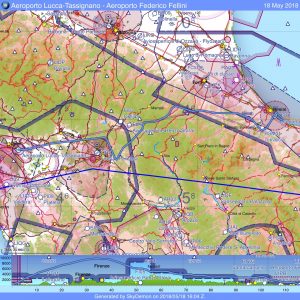
As the aerodrome was technically closed when we landed, we had to wait until the morning to fuel, and this was the most painful of all our transits. I don’t know if the aerodrome was punishing us for making them stay open late the night before, or whether this was normal, but fuelling up our four aircraft and filling out the paperwork took more than two hours. We were furious. Not least because the unstable atmosphere would throw the worst weather at us early to mid afternoon, so getting away early was a priority for us.

We spent about 2 hours in this office, waiting for our paperwork and fees to be processed
We finally set off for Rimini, over very high ground again. I had to keep adjusting track to avoid terrain and cloud, but I found a way through.

en route to Rimini
The arrival into Rimini was via a VRP, and then all the aircraft were positioned for different arrivals. Two downwind left for runway 31, one left base, and we were positioned downwind right hand. I think we had the best view.

Right hand downwind to runway 31
The downwind right hand for runway 31 took us over the beach, tracking just off the shore. To be honest, I thought we were all going to end up on final at the same time, but it all worked out brilliantly!

The apron at Rimini
Because we were flying on to Croatia, we had to clear customs and immigration in Rimini. Unfortunately, one of our crew had dropped their passport in Le Touquet. It had been found on the apron, but it meant it was effectively the end of the road for his participation in the trip. At this point, one aircraft and three pilots set off on a different journey, remaining in Europe, heading back to Britain via Le Touquet. We were handled efficiently at Rimini.
Landing fee: €89.18
Leg 6/10: Rimini – Pula, distance 97nm, flight time 1 hour 2 minutes.
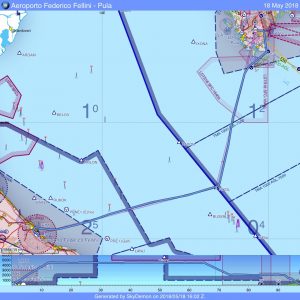
On departure from Rimini, we were routed via waypoint NIKOL to cross the FIR boundary. This was a bit of a deviation from our direct track to Pula, adding to the air-miles over sea. We were also restricted in altitude to 4500ft.
There was very professional ATC at Rimini and Pula again. On arrival to Pula we were instructed to descend to 2000 feet, and to route via two VRPs (S7 and S8). Easy with Skydemon of course.

Final for runway 27 at Pula
We landed and asked for fuel, but had to wait a long time, because there was only one fueler, and he was responsible for all the landing commercial passenger aircraft.

Quirky fuel truck at Pula
In fairness, we had been warned on the phone we’d have to wait, but it ended up taking much longer than any of us expected.

On the ground at Pula, Croatia
We had a lovely night in Pula, and a great meal. We were pretty refreshed for our next leg.

Pula at sunset
Landing fees & 1 night parking fees: 385.84 HRK (€52.31)
Fuel prices: 11.17 HRK per litre (€1.56 per litre)+25% VAT
19 May 2018
Pula – Graz (Diversion) – Linz
Leg 7/10: Pula to Graz (diversion), distance 284nm, flight time 3 hour 1 minute.
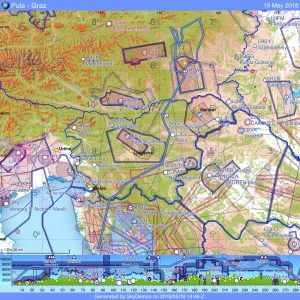
Todays plan had been to fly to Linz in Austria via Slovenia, then onwards to Germany, but midway to Linz the mountains and the cloud were such that I was struggling.

Mountains en route to Linz
At one point I very briefly unintentionally entered a thin layer of IMC. A 180 turn followed, which put me back into VMC, and then a descent to continue. Two of our group made it through a gap in the clouds and mountains, but this gap eluded me.

Cloud tops
I struggled for half an hour to find a route through, eventually descending into a valley. Looking at my fuel calculations, and the worsening weather, I decided to divert to Graz. Throughout this episode I had been calculating fuel, and keeping my options open. I knew I had two aerodromes I believed I could reach, and I also had fields below if a precautionary landing was required.

Mid diversion planning
ATC was amazing again, coordinating my diversion without question and I won’t lie – it was a relief to get on the ground. Unfortunately, the fuel truck would only take cash or a BP card which I didn’t possess. Alastair and I raided our wallets, and managed to cobble together enough money for 56 litres! We popped in the terminal for some water and a sandwich while I re-assessed the situation.
Alastair was very shaken by the flight through the mountains, and I have to say it was probably my most stressful flight to date. At no point were we in danger, but the options were slowly being taken away from us, and I’m glad I made a timely decision to divert.
I could see from the GAFOR forecasts that there was a route to Linz, via Vienna…a very long way around. The forecasts were only valid for the the following two hours, so I had to convince Alastair to set off immediately. He was somewhat reluctant to get going so soon, but it was either that, or we’d not make Linz that day.
Landing Fee: not recorded
Fuel: €2.83 per litre plus 20% VAT
Leg 8/10: Graz to Linz, distance 245nm, flight time 2 hour 30 minutes.
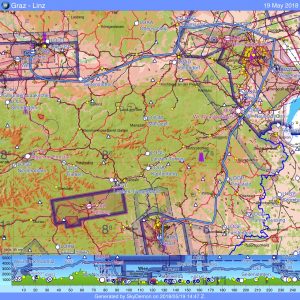
The GAFOR routes give two-hourly forecasts for the route, showing whether it will be suitable for a VFR flight. The routes take you through valleys and along stretches of low ground.

Transit of Vienna airport
We ended up on approach to the south of Vienna, and transiting the airspace was a bit like crossing gatwick. Like Gatwick, we had to orbit twice for a clearance to cross the runway at 1500ft. The controllers weren’t aware of the GAFOR routes, so I had to explain my requested routing via their VRPs.
We followed the Danube river for a bit, and tuned into Linz’s ATIS. There were CBs in the vicinity and to the north, but the aerodrome was in the clear, and our approach was from the south. With the aerodrome chart at our fingertips, we could see that there was a preferred VFR approach, and so when we were cleared via this, we knew what to do.

Short final for Linz
Linz was the most welcoming and helpful of all the aerodromes we visited. We were fuelled up in no time, and the GA reception staff helped us with the information we needed. Alastair and I decided we’d had enough for one day, and as the weather to the north looked dangerous, we found a hotel for the night.

Fuel truck at Linz
Landing & 1 night parking fees: €40.68 inc tax and vat
Fuel prices: €2.10 plus 20% vat
20 May 2018
Linz to Siegerland (Germany) – Lydd
Leg 9/10: Linz to Siegerland, distance 302nm, flight time 2 hours 26 minutes.
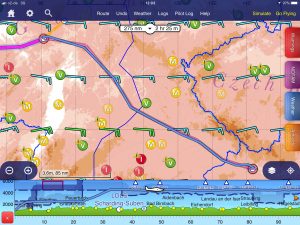
This was the most pleasurable of all of our days flying. We were sad to have been separated from the group, who were now in Germany, but we weren’t under any pressure – we could leave when we were ready.

Getting ready for departure
We filed our flight plan to Germany, paid our landing fee at Linz, then readied the aeroplane. We were routed out of Linz via their VFR sectors, and set course for the north west. What was surprising was the sheer quantity of gliding sites we encountered on our route through Germany, and the quantity of glider pilots out enjoying their sport. It was difficult to plot a route that avoided the sites completely, but I chose the least-worst routing I could find. Unfortunately, this meant at one point that we had to route between two sites, and both were busy with gliders launching, and gliders soaring beneath nearby cumulus cloud. I concentrated my eyes outside the cockpit for 99% of the time, and so my track on this leg was a little circuitous.

Siegerland aerodrome
Siegerland is a smallish aerodrome at an elevation of 2000ft. The AFISO gave us a cheery welcome on frequency, and reminded us to avoid the neighbouring parachute drop zone. We joined downwind for runway 13, and enjoyed the roller coaster of the final approach track over the trees. It was a little gusty!
Siegerland fuellers were very efficient, and we were topped up and paid our landing fee within minutes. We popped into the tower to say hello to the AFISO, who was very friendly, then had lunch in the very good Italian restaurant on site.
We showed our passports to the firefighters before departure, as no border police arrived, then set course for Lydd.
Landing fee: €17.90 inc VAT
Fuel price: €2.00 per litre plus 19% VAT
Leg 10/10 Sigerland to Lydd, distance 310nm, flight time 2 hours 47 minutes.
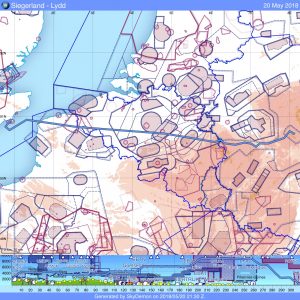
We routed via Liege and to the south of Brussels. We were cleared to transit controlled airspace without hassle. We could see the commercial traffic positioning in the TMA above us. Brussels was a busy frequency, but we were treated with respect.

Brussels to the north of us
I think that’s the main take-away for me from this trip. As a VFR pilot in the UK, I tend to feel like a second or third class citizen. We are sometimes not made to feel welcome in controlled airspace, and the whole process of transiting controlled airspace is a lottery and quite stressful and complicated. By contrast, in all of the rest of Europe we flew on this adventure, I felt an equal relative to the IFR traffic. Our requests were taken seriously, and most requests were approved without hassle. We complied with instructions and restrictions given, and by doing so, we all coexisted safely.
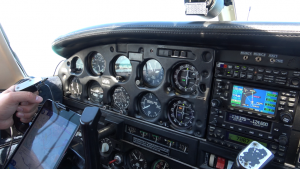
We were deconflicted against two parachute drop aircraft near calais, as we cruised towards the coast at FL95, then were handed over to London Information.
There was a lot of low cloud and mist along the Kent coast, so we requested an RNAV approach to runway 03 at Lydd. Our arrival was in CAVOK conditions though!
Landing fees: £22.80
Fuel prices: £1.50 per litre + 20% Vat
Conclusion
This was a thrilling trip, and one that I will definitely try and do again. Next time, I’ll probably try and do something like this over 10 days or 2 weeks, as it would be nice to spend some time at the destinations we visit. I left much of the weather planning on this trip to my mentor and his two instructors. Given the chance to fly the mountains again on my own, I’d probably try and get advice from a local flying club, and maybe seek the assistance of professional weather forecaster.
The tricky weather in the mountains really tested my skill, decision-making and airmanship. I’m proud to have made a timely decision to divert, rather than to have pressed on into worsening conditions.
